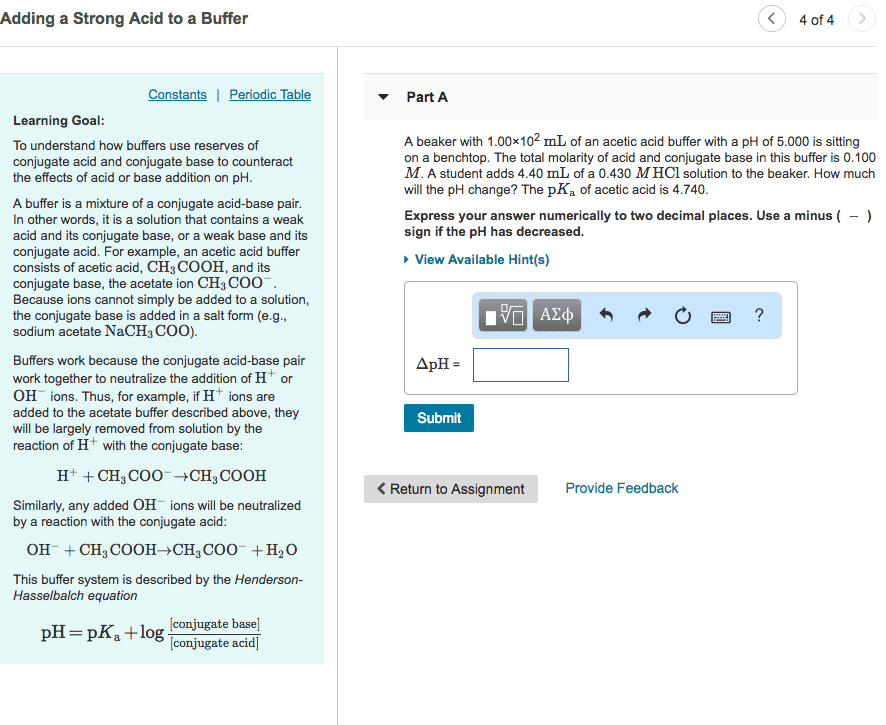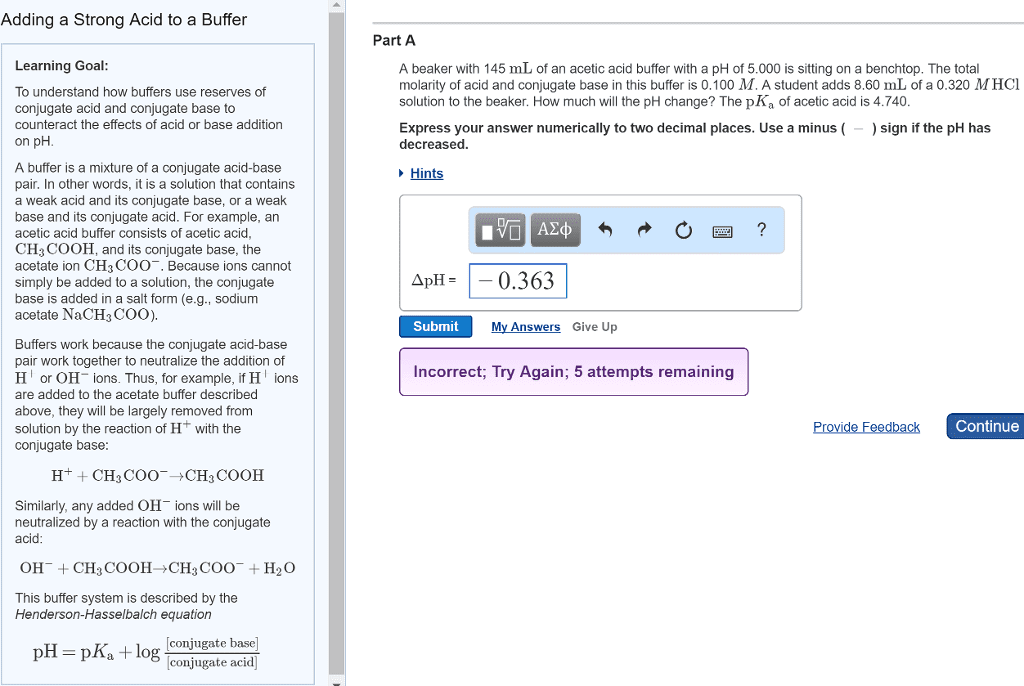BCH 261 Lecture Notes - Lecture 3: Diabetic Ketoacidosis, Inflection Point, Exhalation

Page 1 of 11
Ryerson University – Winter 2018
BCH 261-061 Biochemistry - January 24th, 2018
BCH 261-061 Biochemistry - January 24th, 2018
Buffers
à
What is the effect of a buffer?
Buffers are aqueous systems that resist changes in pH as acid or base is added - composed of a
weak acid and its conjugate base
Example: acetic acid and sodium acetate (CH3COOH + CH3COONa) is a buffer of a weak acid
and its salt
- the Ka of acetic acid is greater than the Kb of its conjugate base acetate
- it acts to keep the hydronium ion concentration (and the pH) almost constant by the
addition of either a small amount of a strong acid or a strong base
- If add a base of sodium hydroxide, the hydroxide ions react with the few hydronium ions
present. Then more of the acetic acid reacts with water, restoring the hydronium ion
concentration almost to its original value
○ If we add an acid such as hydrochloric acid, most of the hydronium ions from the
hydrochloric acid combine with acetate ions, forming acetic acid molecules:
-
○ Example of a buffer of a weak base and its salt } ammonia and ammonium chloride
(NH3(aq) + NH4Cl(aq)) } the pH changes very little.
o a buffer solution allows a shift of the equilibrium between the acid and base to happen
without affecting the pH significantly
o different buffers have different capacities and equilibriums

Page 2 of 11
Ryerson University – Winter 2018
BCH 261-061 Biochemistry - January 24th, 2018
Titration of a weak acid/base: Demonstration of buffering
1. Start with HCOOH @ pH = 1
2. pH initially rises rapidly with the addition
of OH- which consumes H3O+
3. Within the buffer region, continued
addition of OH- and H3O+ is replaced by CHCOOH
4. As OH- is added the pH changes a little
but HCOOH is exhausted. No more buffering
effect which is visualized in the plateau region
5. Midpoint pH = pKa is the inflection point.
At this point is the maximum amount of
acid/base that the buffer is able to withstand
How a buffer works
Buffer solutions are able to minimize the change in pH following the addition of acid/base
because:
o the conjugate acid (HA) and conjugate base (A-) of the buffering compound are present
in sufficient concentration to combine with the added H+ / OH- and neutralize them
o the pH of a weak acid-base solution is least sensitive to added acid or base near the pKa,
where the conjugate acid and conjugate base of the buffer are both present in nearly
equimolar concentrations.
If no buffer was present, there would be ionized changes

Page 3 of 11
Ryerson University – Winter 2018
BCH 261-061 Biochemistry - January 24th, 2018
Henderson-Hasselbalch Equation
o describes the derivation of pH as a measure of acidity (using pKa, the negative log of the
acid dissociation constant)
Example Question
Acetic acid has a pKa of 4.76. You prepare an acetate buffer and the pH is 5.76.
● What’s the ratio of acetate to acetic acid?
pH = pKa + log [A-]/[HA]
5.76 = 4.76 + log [A-]/[HA]
1 = log [A-]/[HA]
inverse(log(1)) = [A-]/[HA]
[A-]/[HA] = 10
● What is the pH of a solution of 0.2 M NaOH?
○ NaOH is a strong base meaning it dissociates completely therefore [OH-] = 0.2 M
○ pOH = -log([OH-]) = -log(0.2) = 0.7
○ pH = 14 - pOH = 14-0.7 = 13.3
● What is the pH of a solution of 0.5 M acetic acid (pKa = 4.76)?
○ Acetic acid is a weak acid à it doesn’t dissociate completely
○ Ka = [H+][Ac-] / [Hac - H+]
■ [H+] = [Ac-]; Total acid = 0.5 M
■ Assume that H+ is much smaller than Hac therefore Hac - H+ is ~= Hac
○ Ka = [H+]2 / [Hac]
○ H+ = sqrt(Ka * [Hac])
○ log [H+] = log (Ka1/2 * [Hac]½)
○ pH = (pKa - log[Hac]) / 2
● How many milliliters of 2.0M solution of boric acid must be added to 600 mL of a solution of
10 mM sodium borate in order for pH to be 9.45 (pKa = 9.24)?
○ Use Henderson-Hasselbalch equation
*** See pages 62-69 of BCH lab manual for more examples
Document Summary
Buffers are aqueous systems that resist changes in ph as acid or base is added - composed of a weak acid and its conjugate base. If add a base of sodium hydroxide, the hydroxide ions react with the few hydronium ions present. Then more of the acetic acid reacts with water, restoring the hydronium ion concentration almost to its original value. If we add an acid such as hydrochloric acid, most of the hydronium ions from the hydrochloric acid combine with acetate ions, forming acetic acid molecules: Titration of a weak acid/base: demonstration of buffering. Start with hcooh @ ph = 1 ph initially rises rapidly with the addition. As oh- is added the ph changes a little of oh- which consumes h3o+ addition of oh- and h3o+ is replaced by chcooh but hcooh is exhausted. No more buffering effect which is visualized in the plateau region.




